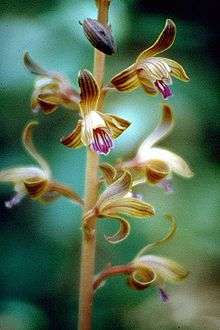Hexalectris
Hexalectris (crested coralroot)[2] is a genus of the family Orchidaceae, comprising 10 known species of fully myco-heterotrophic orchids.[3] These species are found in North America, with the center of diversity in northern Mexico.[4] None of the species are particularly common.[5] Hexalectris spicata has a wide distribution and is likely the most abundant member of the genus, but is nevertheless infrequent throughout its range.[5] Other species are rare, and some, such as H. colemanii, are threatened or endangered.[6] All species that have been studied form associations with ectomycorrhizal fungi that are likely linked to surrounding trees.[7] Many Hexalectris species are found in association with oak trees (Quercus), which are ectomycorrhizal.[8]
| crested coralroot | |
|---|---|
 | |
| Hexalectris spicata | |
| Scientific classification | |
| Kingdom: | |
| (unranked): | |
| (unranked): | |
| Order: | |
| Family: | |
| Subfamily: | |
| Tribe: | |
| Subtribe: | |
| Genus: | Hexalectris Raf. |
| Type species | |
| Hexalectris spicata (Walter) Barnhart | |
Species
Species accepted as of June 2014:[4]
- Hexalectris arizonica (S.Watson) A.H.Kenn. & L.E.Watson (2010) - Arizona, New Mexico, Texas, Coahuila
- Hexalectris brevicaulis L.O.Williams (1940) - central and southern Mexico
- Hexalectris colemanii (Catling) A.H.Kenn. & L.E.Watson (2010) - southern Arizona
- Hexalectris fallax M.I.Rodr. & R.González (2005) - Jalisco
- Hexalectris grandiflora (A.Rich. & Galeotti) L.O.Williams (1944) - widespread from Texas and Chihuahua south to Oaxaca
- Hexalectris nitida L.O.Williams (1944) - from Texas and New Mexico to southern Mexico
- Hexalectris parviflora L.O.Williams (1940) - from Sonora to Guatemala
- Hexalectris revoluta Correll (1941) - western Texas, southeastern New Mexico, northeastern Mexico
- Hexalectris spicata (Walter) Barnhart (1904) - United States from Arizona east to Florida and Maryland
- Hexalectris warnockii Ames & Correll (1943 - Arizona, New Mexico, Texas, northern Mexico
References
- Victoria Sosa "A Molecular and Borphological Phylogenetic Study of Subtribe Bletiinae (Epidendreae, Orchidaceae)" Systematic Botany (2007), 32)1): pp. 34-42 retrieved from http://www.bioone.org/doi/pdf/10.1600/036364407780360175?cookieSet=1
- "Hexalectris". Natural Resources Conservation Service PLANTS Database. USDA. Retrieved 14 May 2015.
- "Flora of North America".
- Kew World Checklist of Selected Plant Families
- Luer, Carlyle A (1975). The native orchids of the United States and Canada, excluding Florida. New York: New York Botanical Garden. OCLC 1348145.
- Kennedy, Aaron H.; Watson, Linda E. (2010). "Species Delimitations and Phylogenetic Relationships within the Fully Myco-heterotrophic Hexalectris (Orchidaceae)". Systematic Botany. 35 (1): 64–76. doi:10.1600/036364410790862489.
- Kennedy, Aaron H.; Taylor, D. Lee; Watson, Linda E. (2011-03-01). "Mycorrhizal specificity in the fully mycoheterotrophic Hexalectris Raf. (Orchidaceae: Epidendroideae)". Molecular Ecology. 20 (6): 1303–1316. doi:10.1111/j.1365-294x.2011.05000.x. ISSN 1365-294X. PMID 21255173.
- Coleman, Ronald A. (2005). "Populations Studies in Dichromanthus and Hexalectris in Southeastern Arizona". Selbyana. 26 (1/2): 246–250. JSTOR 41760196.
External links


- US Department of Agriculture plants profile, Hexalectris spicata
- Go Orchids,North American Orchid Conservation Center, Hexalectris spicata
- New Mexico Rare Plants, Hexalectris nitida (Shining crested coralroot, Glass Mountain crested coralroot)
- Lady Bird Johnson Wildflower Center, University of Texas @ Austin, Hexalectris spicata (Walter) Barnhart Spiked crested coralroot